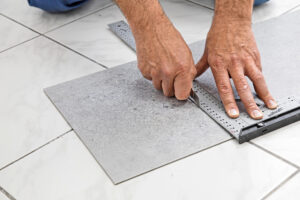- 2 min reading time
Remove or cover old floors – which is the better solution?
Whether renovating, redesigning or refurbishing, the question often arises with ageing floors: should the old floor be removed or simply covered? Both options have their advantages and disadvantages – and they have a decisive impact on the amount of work involved, costs and sustainability. In this article, we show you what matters – and what advantages modern design floor coverings such as CERAMIN® offer.
Removing flooring – the classic method with substance
Advantages:
- A clean start: during removal, the substrate can be professionally inspected, levelled and prepared.
- No compromises on installation height: Every millimetre counts, especially when renovating – door frames, furniture and stair connections remain unaffected.
- Removal of old pollutants: Older PVC or carpet flooring in particular can contain harmful substances such as plasticisers or asbestos.
Disadvantages:
- Time-consuming and costly: Removing old flooring, especially if it is glued down, can be a laborious task.
- Noise, dust & disposal: A particular challenge in inhabited rooms – and not always feasible.
Covering old floors – the smart alternative
Advantages:
- Quick renovation without demolition: Ideal for rented flats or when time is tight.
- Less dirt, less effort: no noise, no dust, no disposal – a real bonus in everyday life.
- Acting more sustainably: Existing materials are preserved – in combination with a recyclable floor covering such as CERAMIN, this is an environmentally friendly solution.
Requirements:
- The old floor must be stable, level and dry.
- Soft surfaces such as carpets or loose tiles are not suitable.
- The installation height and impact sound should be carefully checked.
CERAMIN – the perfect solution for both approaches
Whether you decide to completely remove the old floor or plan to cover it, CERAMIN design floor coverings offer you maximum flexibility.
Why CERAMIN®?
- Extremely dimensionally stable – even when floating installation
- Ideal for old tiles thanks to low installation height
- Low emissions & healthy living – no PVC or plasticisers
- 100% recyclable – it couldn't be more sustainable
CERAMIN really shows its strengths when laid on old tiles or screed: the floor is particularly thin and resilient.
Our conclusion: It depends on the floor and your goals.
Choose to remove if:
- Contaminants suspected in old coating
- the old floor is badly damaged
- you want to play it safe in the long term and technically
Select the overlay if:
- you want to work sustainably and conserve resources
- the old coating is stable
- you want to save time, money and effort
With CERAMIN flooring, you are in good hands in both cases.



